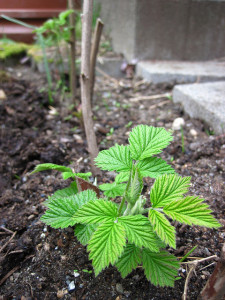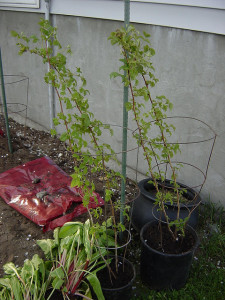
Photo Credit: majorbonnet on flickr.com
“If they’re green, I make sure they don’t lean; If they’re brown, I cut them down.”
We’ve been blessed with neighbors that cultivate wonderful thornless raspberries and wild birds that steal the same. The birds are smart, too – they don’t eat them until they come to our yard… or, perhaps they DO eat them there and then come to our house for – other reasons…
Blackberries, blueberries and alpine strawberries also grace our yard, probably for the same reason.
Left to the elements and an inoperative lawnboy, I would be doing battle with canes both sharp and de-clawed to get to my garden like Prince Valiant trying to get to Sleeping Beauty (did she sleep in a garden bed?).
Several years ago I attempted to give the thornless variety a plot of their own, and they did poorly. Last year I plowed them under with the lawn mower, then found myself busy – too busy to keep mowing them down), and they gave like Jersey cows. This year, I’ve followed our neighbor’s lead by cutting them down to 2 ft tall, and the blackberry canes to 3 ft tall. At this height the canes aren’t leaning over. Any of them that I do find leaning get cut down to nothing. We have plenty, and they’ll probably start again.
I’ve seen that people also grow these in containers (24 in. diameter minimum). I may try the thornless variety this way if I run across a lot of pots at the recycling center (as I often do every year) or I can find the ones that haven’t been recycled by my wife (we are sometimes competitive packrats: we’ll hold up a handful of this or an armful of that with a look – and then the other will admit to their err with a glance at the ground or a toe digging into the dirt, signalling surrender of what was once an impulsive treasure).
Instead of treating the canes with a standard 10-10-10 fertilizer, a similar natural based supplement or neglect, a spring feeding of 5-4-3 fertilizer is recommended by BackyardBerryPlants.com right around now, and another feeding right before they bloom. The site also gives advice for mulching, etc., which I may do for the thornless, but the volunteers that paratrooped in (poopertrooped in?) may just get a feeding.
After the harvest, I’m supposed to cut the canes to the ground. Easy enough for the raspberries as long as my mower blade is sharp. As for the blackberries which grow around the fringes of the yard I’ll probably continue with my spring cleaning method:
If they’re green, I make sure they don’t lean; If they’re brown, I cut them down.










Recent Comments